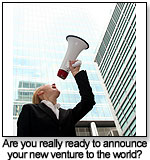
April 18, 2024

October 2011 | Vol. X - No. 10
Are You Really Ready For PR? Part 1
Lisa Orman Shares How You Know You're Ready For PR
Read Part II
 Many toy or game companies see others using public relations successfully, whether they are companies with a full-time, in-house employee managing their PR, working with an outside PR agency or freelancer, or both. It’s understandable why they’d want to follow in these companies’ footsteps—who wouldn’t want to be glorified on a national TV show, touted in a national magazine, or buzzed about by mommy bloggers?
Many toy or game companies see others using public relations successfully, whether they are companies with a full-time, in-house employee managing their PR, working with an outside PR agency or freelancer, or both. It’s understandable why they’d want to follow in these companies’ footsteps—who wouldn’t want to be glorified on a national TV show, touted in a national magazine, or buzzed about by mommy bloggers?
Someone who’s not quite ready for prime time, that’s who.
Bring Something New to the Table
Many entrepreneurs or start-up companies call me to talk about how we can help them with PR, and the first thing I assess is whether I believe their product, service, or product line is newsworthy. Is their product just another toy, like so many others already out there? Or is it creative and different? Does it do something better or new, teach something in a new way or meet a need? Is it well made? Why does the company feel the need to produce this toy or game or create this service? Have they truly researched the market, and do they feel they are bringing something new and different to the table? A patent or patent-pending is not necessary, but it is a nice indicator of something being truly different.
See examples and solutions to problems surrounding the protection of your unique idea.
Plan Ahead
It’s great to consult a publicist in the early stages to hear their opinion on whether your product will succeed with publicity. It allows you to get a feeling for budget and timing, so you know how to proceed when you’re ready. In an ideal world, you’d work with that publicist on a consulting or hourly basis while you develop your product, packaging, sell sheets, website and other key materials, so they can give you feedback and input from a publicity point of view.
I tell people to sign on a retainer relationship with a publicist even if all they have are prototypes in the U.S. and the final product is still on a boat. That way publicist can gauge their chances of PR success. That gives you about 3-4 weeks’ lead time before you’re shipping product to retailers, and you can reserve some samples for PR purposes before it all leaves for store shelves. There still can be unforeseen delays in customs, or other factors that can push your timing back, but at least you’re in the ballpark this way.
See examples and solutions to problems surrounding general delays, customs, and safety testing.
Take Advantage of Trade Shows
Next, I talk to clients about how they’ll sell their product. Many of them ambitiously hope to sell directly to retailers with their own (very limited) resources, without prior relationships or contacts with retailers, or even a sense of how many there are in specialty or mass. There are so many trade shows that can help my clients meet the right retailers, gain an understanding about how sales reps or managers might help take their business to the next level, and what they will need to do to help their product succeed at retail.
 Whether it’s American International Toy Fair, ABC Kids Expo, one of the big gift, hobby, book shows, or ASTRA, I try to listen to my clients’ sales goals and guide them toward the best shows. In general, your company can benefit far more from great PR if you have strong shelf presence at whichever stores you are target, as well as good online sales resources. When readers see your product’s rave review, they can easily seek it out online. Or, if it’s beckoning to them from a shelf in a store they’re in, it might become an impulse purchase.
Whether it’s American International Toy Fair, ABC Kids Expo, one of the big gift, hobby, book shows, or ASTRA, I try to listen to my clients’ sales goals and guide them toward the best shows. In general, your company can benefit far more from great PR if you have strong shelf presence at whichever stores you are target, as well as good online sales resources. When readers see your product’s rave review, they can easily seek it out online. Or, if it’s beckoning to them from a shelf in a store they’re in, it might become an impulse purchase.
Drive Sales By Licensing
Sometimes accomplishing this seems insurmountable, so the best course of action is to license their idea with a reputable manufacturer or distributor who can complete the design and packaging, manufacture at a competitive price, and manage sales and trade shows. The inventor earns a licensing fee for each item sold to retail. I’m especially likely to suggest this if I my client needs or wants to keep their day job.
Price to Please
Another key ingredient for PR readiness is proper pricing. Too high or low a price can be a red flag for a publicist. If your product is priced too low relative to its perceived value, you’ve undersold yourself and not done a good job communicating quality and play value. If the price is too high, based on how much it cost you to get it made and shipped rather than on market research on what consumers are willing to pay for similar products, your volume will suffer and so will your company.
I have heard from many start-ups, “we have to charge this much because the tooling, materials and shipping cost so much and we have to double it.” Sometimes in the beginning you have to sacrifice margin to get your price right and get your sales going. I have had editors tell me, “I love this _____, but my readers will never spend this much money on an item like this so I just can’t cover it.”
Perfect Your Packaging
Attractive and compelling packaging is key to retail success. This is the chance to convey what’s inside, and why the consumer must have it. Attractive packaging can also work its magic on picky editors who see thousands of products each month, and are looking for items that visually stand out.
See examples and solutions to problems surrounding product photography and packaging.
Link, Like, and Tweet
Make sure your website is ready for prime time, and have a Facebook and Twitter company page set up before you engage in a PR campaign. Have a section on your site devoted to your press results, and clearly list your publicist’s contact information on your site so reporters can easily find it. Have someone at your company committed to posting your press results regularly, and linking back to the sources from your social media pages with company comments, even if it’s a simple “thanks.”
Learn more about how having an early media presence can protect your brand.
 Budget
Budget
Once you’ve decided to use PR and found someone who’s a good fit to spearhead the effort, it’s important to take seriously the commitment you’re making. Whether it’s a project or retainer relationship you’ve opted for, be sure you have funds allocated from the budget (not from cash flow or reliant on sales and accounts receivable). Many times companies cut things too tightly and have to abandon their PR plan prematurely because they didn’t budget for it properly.
See examples and solutions to problems surrounding budget & finance.
Commit
PR is not the kind of thing you can turn on and off like a faucet. Since we’re in the business of creating and building long-lasting relationships with reporters, publicists hate when they don’t get to complete a project and serve reporters’ needs through to their intended end. It’s also not fair to the client, since they will not reap the full benefits of the campaign if the plan is not executed and followed through.
Make sure you are clear on your goals for your PR campaigns: what does success look like? If you can envision it before you start, you’ll know if you accomplished it when you get there.
Want to see examples of PR problems that can arise and their solutions? Read Trial and Error - Are You Really Ready For PR? Part 2
Copyright © 2024 TDmonthly®, a division of TOYDIRECTORY.com®,
Inc.



 Many toy or game companies see others using public relations successfully, whether they are companies with a full-time, in-house employee managing their PR, working with an outside PR agency or freelancer, or both. It’s understandable why they’d want to follow in these companies’ footsteps—who wouldn’t want to be glorified on a national TV show, touted in a national magazine, or buzzed about by mommy bloggers?
Many toy or game companies see others using public relations successfully, whether they are companies with a full-time, in-house employee managing their PR, working with an outside PR agency or freelancer, or both. It’s understandable why they’d want to follow in these companies’ footsteps—who wouldn’t want to be glorified on a national TV show, touted in a national magazine, or buzzed about by mommy bloggers?  Whether it’s American International Toy Fair, ABC Kids Expo, one of the big gift, hobby, book shows, or ASTRA, I try to listen to my clients’ sales goals and guide them toward the best shows. In general, your company can benefit far more from great PR if you have strong shelf presence at whichever stores you are target, as well as good online sales resources. When readers see your product’s rave review, they can easily seek it out online. Or, if it’s beckoning to them from a shelf in a store they’re in, it might become an impulse purchase.
Whether it’s American International Toy Fair, ABC Kids Expo, one of the big gift, hobby, book shows, or ASTRA, I try to listen to my clients’ sales goals and guide them toward the best shows. In general, your company can benefit far more from great PR if you have strong shelf presence at whichever stores you are target, as well as good online sales resources. When readers see your product’s rave review, they can easily seek it out online. Or, if it’s beckoning to them from a shelf in a store they’re in, it might become an impulse purchase.  Budget
Budget